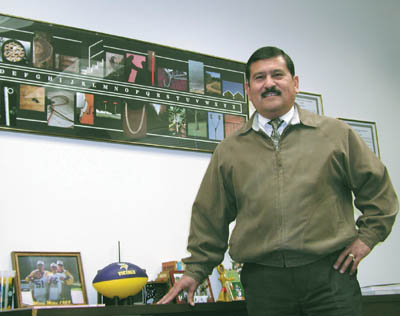
To ensure that every child has the opportunity to receive an
education, San Benito County has a network of alternative education
programs for students who do not succeed at traditional
schools.
Santa Ana Opportunity School and San Andreas Continuation High
School are for students who have experienced behavior and
discipline problems at traditional schools such as San Benito and
Anzar high schools, and Pinnacles Community School and San Benito
County Juvenile Court School for students with further behavior and
discipline problems.
To ensure that every child has the opportunity to receive an education, San Benito County has a network of alternative education programs for students who do not succeed at traditional schools.
Santa Ana Opportunity School and San Andreas Continuation High School are for students who have experienced behavior and discipline problems at traditional schools such as San Benito and Anzar high schools, and Pinnacles Community School and San Benito County Juvenile Court School for students with further behavior and discipline problems.
As of mid-January, 33 students were enrolled at Pinnacles Community School and 23 attended the Juvenile Court School. There is one class at the court school and three at Pinnacles, which allows for more individual attention to students.
“(The two schools) provide the most individual support for students,” said county Superintendent of Schools Tim Foley. “It’s a short, intensive program where kids don’t fall through the cracks.”
Students taking classes at the Juvenile Court School are serving time in Juvenile Hall. They can be at the school for one to 90 days, depending on the amount of time they are serving. Students in Juvenile Hall can be serving time for offenses from petty theft to assault or violation of probation, said Deborah Botts, the county’s chief probation officer.
“Juvenile Hall is a juvenile version of jail,” Botts said. “It’s a holding facility to make sure kids make it to school. It makes sure the kids don’t victimize anyone. We want them to develop a pattern and keep it. (Juvenile Hall) protects the child, the victim and the community.”
Students at the Juvenile Court School range from a sixth-grader to second-semester 12th-graders, said teacher Genie Yamaoka. Most students spend 30 days at the school, she said.
Because of the range of ages and the shortness of time spent at the court school, students take individual study while Yamaoka and a teacher’s aide keep them on task.
After students at the court school are released, they are enrolled at Pinnacles Community School to help them return to the school they came from. If the student is gone for less then 10 days, they can return to their original school.
Most of the students attending the court school and Pinnacles filter back into their original school, said Mike Sanchez, director of alternative education and principal at all four campuses.
While having behavioral and discipline problems can put a student behind, most are on track to returning to a four-year school, Sanchez said. The point of the alternative education network is to “develop the best possible program for students,” he said.
Pinnacles Community School is for students who have failed to succeed at other schools.
“Students go to Pinnacles who haven’t made it somewhere else,” Foley said. “It’s a gentle and peaceful place out there.”
Even though the environment may be more informal and relaxed, students are always working, Sanchez said.
“The students are not just hanging around,” he said. “They are expected to be on task.”
Pinnacles school offers an accelerated reading program where students can check out books and take them home. Many students pick up a habit of reading, Sanchez said.
“The parents will come home and their child is reading and they (the parents) tell me they’ve (the student) never read like that before,” he said.
All students are required by state law to attend school, even if they have been expelled or have committed crimes. The Juvenile Court School ensures that students serving time are schooled while Pinnacles Community School allows students with behavior or discipline problems or those who come from the court school to keep studying and receiving instruction.
Both the court school and Pinnacles offer four-hour programs each school day. Sanchez is director of all alternative schools to allow for communication between the four. This way, teachers and administration at each school know where students are in the alternative education program.









